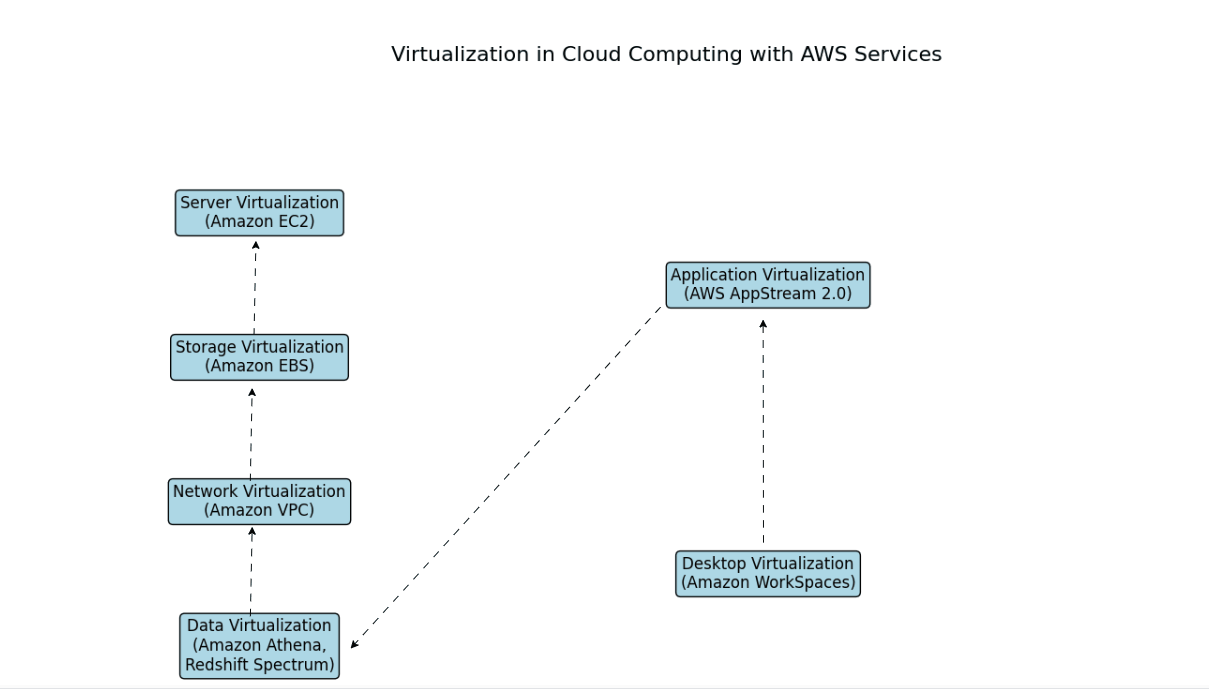🌟 Understanding Virtualization in Cloud Computing: A Beginner's Guide
 Sprasad Pujari
Sprasad Pujari
Hey there, tech enthusiasts! Today, we're diving into the fascinating world of virtualization in cloud computing. Don't worry - we'll keep it simple and fun! Let's explore how virtualization makes cloud computing possible and look at some real-world examples you can try yourself.
🎯 What is Virtualization?
Think of virtualization as magic that lets you create multiple "virtual" versions of something from a single physical resource. It's like having one pizza and somehow making multiple identical copies that everyone can enjoy independently! In tech terms, it's taking one physical computer and creating several virtual ones that work independently.
🔄 Types of Virtualization in Cloud Computing
1. 💻 Server Virtualization
What it is:
Creating multiple virtual servers from one physical server
Each virtual server acts like a completely independent computer
Runs its own operating system and applications
Real-world Example: Let's say you're running a small business website. Instead of buying three separate servers for your website, database, and email system, you can use one physical server and create three virtual servers using AWS EC2.
Mini Project: "My First Virtual Server" 🚀
Sign up for AWS Free Tier
Launch an EC2 instance
Install a web server (like Apache)
Host a simple website
2. 💾 Storage Virtualization
What it is:
Creating virtual storage from multiple physical storage devices
Makes storage management easier and more flexible
Like having one giant hard drive made up of many smaller ones
Real-world Example: Imagine you're a photographer storing client photos. Using Amazon EBS, you can create virtual storage volumes that grow with your needs without buying new hard drives.
Mini Project: "Flexible Photo Storage" 📸
Create an EBS volume in AWS
Attach it to your EC2 instance
Use it to store and manage your files
Create automated backups
3. 🌐 Network Virtualization
What it is:
Creating virtual networks independent of physical network hardware
Like having multiple private networks within one physical network
Improves security and network management
Real-world Example: A company wants to separate its development, testing, and production environments. Using Amazon VPC, they can create three isolated virtual networks within AWS.
Mini Project: "Secure Network Setup" 🔒
Create a VPC in AWS
Set up public and private subnets
Configure security groups
Connect your EC2 instances
4. 📊 Data Virtualization
What it is:
Accessing and managing data from different sources as if it's in one place
No need to copy or move data around
Like having one search box for all your files, regardless of where they're stored
Real-world Example: A retail company wants to analyze data from their website, mobile app, and in-store sales. Using Amazon Athena, they can query all this data directly from S3 without moving it.
Mini Project: "Data Analytics Hub" 📈
Store different types of data in S3
Set up Amazon Athena
Create SQL queries to analyze your data
Build simple dashboards
5. 📱 Application Virtualization
What it is:
Running applications independently of the operating system
Makes apps portable and easier to manage
Like having apps in their own protective bubbles
Real-world Example: A school wants to provide expensive design software to students. Using AWS AppStream 2.0, students can access the software from any device without installing it.
Mini Project: "Virtual App Deployment" 🚀
Set up AWS AppStream 2.0
Configure an application
Test streaming to different devices
Monitor usage and performance
6. 🖥️ Desktop Virtualization
What it is:
Accessing your complete desktop environment from anywhere
All your files and applications available on any device
Like carrying your computer in the cloud
Real-world Example: A company with remote workers uses Amazon WorkSpaces to provide secure, consistent desktop environments to all employees, accessible from any device.
Mini Project: "Cloud Desktop Setup" 💼
Create an Amazon WorkSpace
Customize the desktop environment
Install required applications
Test access from different devices
🌟 Benefits of Virtualization
💰 Cost Savings: Use resources more efficiently
🚀 Scalability: Grow or shrink resources as needed
🔄 Flexibility: Change configurations quickly
🛡️ Better Security: Isolate different environments
💪 Improved Reliability: Easier backup and recovery
🎓 Getting Started Tips
Start with AWS Free Tier to experiment
Begin with simple server virtualization projects
Practice creating and managing virtual resources
Join AWS community forums for support
Document your learning journey
🔮 Conclusion
Virtualization is the backbone of modern cloud computing, making it possible to do amazing things with fewer physical resources. Whether you're a student, developer, or business owner, understanding virtualization opens up endless possibilities for building efficient and scalable solutions in the cloud.
Remember: The best way to learn is by doing! Start with the mini-projects above and gradually build more complex solutions as you get comfortable with the concepts.
Happy virtualizing! 🚀✨
Thank you for joining me on this journey through the world of cloud computing! Your interest and support mean a lot to me, and I'm excited to continue exploring this fascinating field together. Let's stay connected and keep learning and growing as we navigate the ever-evolving landscape of technology.
LinkedIn Profile: https://www.linkedin.com/in/prasad-g-743239154/
Feel free to reach out to me directly at spujari.devops@gmail.com. I'm always open to hearing your thoughts and suggestions, as they help me improve and better cater to your needs. Let's keep moving forward and upward!
If you found this blog post helpful, please consider showing your support by giving it a round of applause👏👏👏. Your engagement not only boosts the visibility of the content, but it also lets other DevOps and Cloud Engineers know that it might be useful to them too. Thank you for being so supportive! 😀
Thank you for reading and happy deploying! 🚀
Best Regards,
Sprasad
Subscribe to my newsletter
Read articles from Sprasad Pujari directly inside your inbox. Subscribe to the newsletter, and don't miss out.
Written by

Sprasad Pujari
Sprasad Pujari
Greetings! I'm Sprasad P, a DevOps Engineer with a passion for optimizing development pipelines, automating processes, and enabling teams to deliver software faster and more reliably.